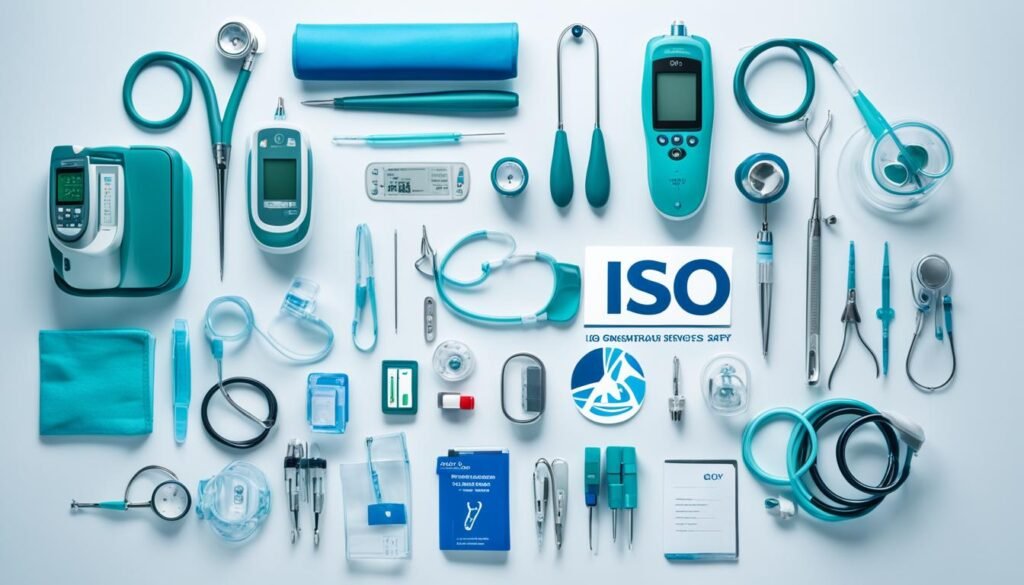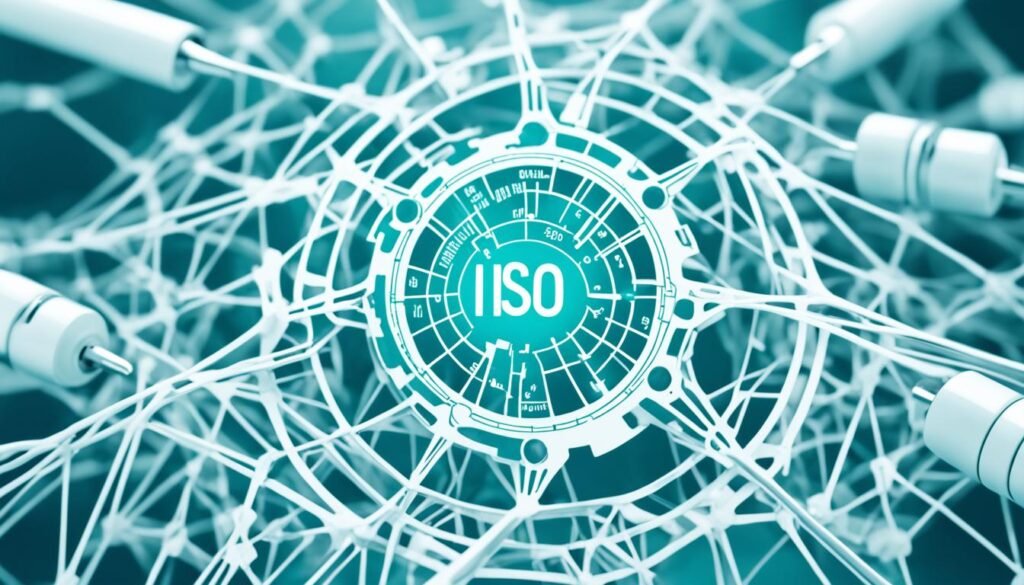Do you know that moving from ISO 9001 to THY Precision iso standards for medical devices and iso13485meaning is key for medical device makers? We’ll explore why these standards matter, their main rules, and how ISO 9001 and ISO 13485 compare. Knowing the changing rules helps your medical device company stay in line and keep a strong quality system.
Key Takeaways
- Understand the importance of iso standards for medical devices and iso13485meaning in the medical device industry.
- Explore the key requirements of ISO 13485 and how they differ from ISO 9001.
- Discover the benefits of implementing iso standards for medical devices and iso13485 meaning in your organization.
- Recognize the challenges associated with transitioning to these standards and how to overcome them.
- Stay up-to-date with the evolving regulatory landscape and ensure your medical device company remains compliant.
What is ISOstandardsformedicdevicessandiso13485meaning?
ISO standards for medical devices and ISO 13485 are key for companies making and selling medical devices. ISO 13485 is a quality management system standard. It shows that companies can make products and services that meet customer and law needs.
Defining ISO Standards for Medical Devices and ISO 13485 Meaning
The ISO standards for medical devices and ISO 13485 meaning talk about a global standard for the medical device field. This standard looks at many things like risk management and making sure products are traceable. It aims to keep medical devices safe and high quality from start to finish.
ISO 13485 is a big help for companies in the medical device field. It lets them set up and keep a quality management system that fits the industry’s needs. By using this standard, companies show they care about quality, safety, and following the law. This is very important in the strict medical device market.
| Key Elements of ISO 13485 | Description |
|---|---|
| Quality Management System | Creates a structured way to manage quality, including documents, steps, and who does what. |
| Risk Management | Finds and lowers risks linked to making and using medical devices. |
| Regulatory Requirements | Makes sure companies follow the laws for medical devices in the country and around the world. |
| Supplier and Traceability | Keeps an eye on the supply chain and makes sure medical devices and parts can be traced. |
| Continuous Improvement | Helps improve the quality management system and how well the company does things. |
Following the ISO standards for medical devices and knowing the ISO 13485 meaning shows that companies are serious about quality, safety, and following the law. This is very important in the strict medical device market.
“Implementing ISO 13485 helps medical device manufacturers build trust and credibility with their customers and regulatory authorities.”
Importance of ISOstandardsformedicdevices and iso13485meaning
Using iso standards for medical devices is key for those making and selling medical gear. ISO 13485 sets clear rules for making sure medical devices are safe and work well. It helps keep the production of medical devices consistent.
Key Requirements of ISO 13485
The main points of iso 13485 are:
- Risk management: Finding and fixing risks in medical devices.
- Product traceability: Keeping track of where medical devices come from and where they go.
- Supplier evaluation: Checking if suppliers meet quality standards.
- Documented procedures: Having clear steps for making, producing, and fixing medical devices.
- Corrective and preventive actions: Putting in place systems to fix and prevent problems.
Following these iso standards for medical devices and the iso 13485 meaning is important. It helps companies meet laws, lower risks, and show they care about quality and patient safety.
“Implementing iso standards for medical devices and understanding the iso 13485 meaning is crucial for medical device manufacturers to ensure the production of safe and effective products.”

ISO 9001 vs. ISO 13485: Differences and Similarities
ISO 9001 and ISO 13485 are both quality management system standards. But, they have big differences. ISO 9001 is for many types of organizations. ISO 13485 is made just for the medical device industry.
ISO 13485 has extra rules about managing risks, tracing products, checking suppliers, and following laws. These rules are not in ISO 9001.
Yet, both ISO standards focus on making customers happy and using a process-based approach. They also use the Plan-Do-Check-Act cycle for getting better. Knowing the differences and what they have in common is key for THY Precision, a medical device maker. This knowledge helps them move from ISO 9001 to the stricter ISO 13485 rules.
| Comparison Criteria | ISO 9001 | ISO 13485 |
|---|---|---|
| Scope | General quality management system standard | Specific to medical device industry |
| Focus | Customer satisfaction | Regulatory requirements and risk management |
| Product Traceability | Not a specific requirement | Mandatory for medical devices |
| Supplier Evaluation | General requirements | More stringent requirements for medical device suppliers |
| Regulatory Compliance | Not a specific focus | Essential requirement for medical devices |
THY Precision can smoothly move from a general quality system to the specific needs of medical device making with ISO 13485. This is by understanding the main differences and what they share.
Transition from ISO 9001 to ISOstandardsformedicdevices and iso13485meaning
Medical device makers with an ISO 9001 certification need to move to iso standards for medical devices and grasp iso 13485 meaning. This step is key to keep up with rules and keep their products quality high. They must adjust their quality management system to fit ISO 13485’s needs. This includes more focus on managing risks, tracing products, checking suppliers, and following rules.
Switching over might mean big changes to policies, steps, and documents to meet iso 13485‘s higher standards. It’s important to plan and do this change well to keep your certification and access to the market. Knowing the differences between ISO 9001 and iso standards for medical devices helps device makers move over smoothly. This ensures their quality systems meet industry rules.
| Key Considerations for Transitioning to iso standards for medical devices and iso 13485 meaning |
|---|
|
By taking steps now to adapt to iso standards for medical devices and iso 13485 meaning, device makers can keep their quality systems strong. They will stay compliant and ready for the industry’s changing rules.
Benefits of Implementing ISOstandardsformedicdevices and iso13485meaning
Implementing iso standards for medical devices and understanding iso 13485 meaning brings big benefits to the medical device industry. It boosts product quality and patient safety. It also gives a competitive edge in the market.
One key advantage is better quality and patient safety. These standards ensure safe and effective medical devices. They do this through strong quality management and risk management.
Being compliant with iso 13485 meaning also meets strict medical device regulations. This makes it easier to get into the market and keeps the license to operate. It protects patients and boosts the company’s reputation.
Another big plus is better supplier management. The standard’s rules for checking suppliers ensure a reliable supply chain. This means less risk of product failures or recalls.
The standard also makes processes more efficient. It improves traceability and cuts waste. This leads to saving costs and making more money for the company.
Finally, following iso standards for medical devices gives a competitive edge. It builds trust with customers and authorities. It shows the company’s dedication to quality, safety, and following the rules.
In summary, the benefits of iso standards for medical devices and iso 13485 meaning are many. They include better quality, patient safety, and operational efficiency. For medical device companies, these standards are key to success and leadership in the market.
Challenges in Implementing ISOstandardsformedicdevices and iso13485meaning
Implementing iso standards for medical devices and understanding iso 13485 meaning can be tough for many companies. These quality management systems bring big benefits, but they also come with challenges.
One big challenge is the need for lots of documentation. Companies must create and keep up with policies, procedures, and records. This takes a lot of time and effort, needing a big team.
Switching to a new quality management system also means big changes for a company. It affects everything from how things are done to the company culture. Getting everyone on board with these changes can be hard.
It’s also key to make sure all staff know what they need to do to follow iso 13485 meaning. Training and developing skills are essential for success.
Finally, getting enough money and people to put into an iso 13485 meaning-compliant system can be tough, especially for small companies. Keeping up with new rules can also make things more complicated.
But, companies that can get past these hurdles can see big benefits. They’ll have better quality, follow rules better, and be more competitive in the market.

| Challenge | Description |
|---|---|
| Extensive documentation requirements | Developing and maintaining the necessary policies, procedures, records, and quality system documentation can be time-consuming and resource-intensive. |
| Organizational change management | Transitioning to a new quality management system may require significant changes in organizational culture, processes, and responsibilities, which can be difficult to manage. |
| Staff training and competency | Ensuring that all personnel involved in the medical device lifecycle have the necessary skills and knowledge to comply with ISO 13485 requirements can be a significant undertaking. |
| Resource allocation | Implementing and maintaining an ISO 13485-compliant quality management system may require the allocation of additional financial and human resources. |
| Adapting to evolving regulatory requirements | The medical device industry is subject to frequent regulatory changes, requiring organizations to continuously update their quality management systems to remain compliant. |
By tackling these challenges, companies can make the most of iso standards for medical devices and stick to iso 13485 meaning. This leads to better quality, following rules, and being more competitive in the medical device field.
Conclusion
Switching from ISO 9001 to iso standards for medical devices is key for companies in the medical field. ISO 13485 sets clear rules for quality management. This ensures safe and effective medical devices, meeting laws and keeping patients safe.
Adopting iso standards for medical devices and iso 13485 meaning comes with challenges. Yet, the perks like better quality management systems, regulatory compliance, and smoother supplier management are big pluses. These benefits make it a smart move for medical device makers.
By following these iso standards for medical devices, companies can stand out. They build trust with customers and regulators. This helps make the medical devices they make safer and of higher quality.
THY Precision leads in making precision medical parts. They’ve made the switch to iso standards for medical devices and understand iso 13485 meaning well. Their focus on quality and following the rules has kept them a top choice in the industry. They offer innovative solutions that meet the highest regulatory compliance standards.